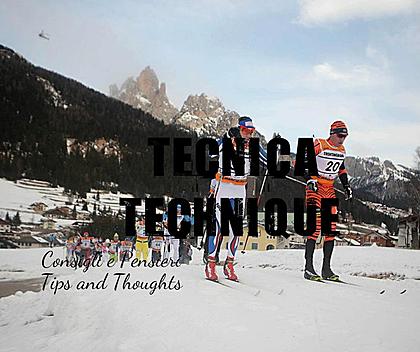Official Sponsors


31.05.2026

| News date | 18.10.2016 |
Good morning Marcialonga lovers and welcome again to Tips and Thoughts. The date of the Marcialonga is getting closer so we analyse today, with the technician of the Fiamme Gialle Ski Team Andrea Zattoni, the evolution of the technique over the years, trying to understand if the Double Poling is really suitable for everybody.

Almost half a century ago, when the first edition of Marcialonga were held, the only technique known was the classic style, that included the classic striding, the triple step, the kick-double-pole. In most of these movements, due to the equipment and grooming not always at high standards, the skiers used mostly the legs as pushing force. The skis were waxed from head to tail guaranteeing a very good grip, whereas the pretty short poles could not allow a long pushing with the arms.
The first evolution: the free technique
Over the years, the development of the materials to make skis, shoes and poles, and the introduction of the snowmobiles to prepare the tracks, have led to an evolution of the of the skier’s movements. Between the end of ’70s and the beginning of ‘80s we can see the first testing of the skate technique, when athletes started to put one leg out of the track for skating, combining both the legs and the arms push.
In just a few years everyone used to skate. One of the greatest event in the history is represented by the victory in the Wold Cup 1982 of William Conrad “Bill” Koch from USA, the first champion of the so called “free technique” (the skiers could choose which technique to use). The style was changing and even in the Marcialonga the competitors started to skate. The first victory in free technique dates back to 1985: Giorgio Vanzetta was the first to pass the finish line using skis without wax.
Materials and style rapidly improved: faster skis, higher and lighter poles, the fluorine wax, wider ski slopes. It seemed that the classic technique could even disappear.
The victories of De Zolt, Botvinov and Gutierrez made history, but in 2003 Marcialonga returned to classic style and the Nordic Countries, especially Norway, became the king of the race. Jorge Aukland won the 30th edition with waxed skis, over a distance of 60 km.
A new revolution?
In 2004 something unthinkable happened. Anders Aukland, the older brother of Jorgen, who already won the gold medal at the Olympic Games 2002 and two more WC gold medals in 2003, faced the Marcialonga course over 70 km using skis without wax. From this moment on, all the long distance athletes started to compete without using the wax.
Double Poling, as already explained by Enzo Macor in the previous text, is a movement where only the arms push while skis remain in the track. This technique changed over the years: at the beginning the arms pushed hard with the bust completely bent forward; nowadays the push act is more efficient due to the use of the core and of the legs.
To face the 70 km of Marcialonga, using only the double poling technique, could be a successful system, but it is necessary to do it in the right way (even for not to be disqualified) and with a very good athletic preparation and technique.
My advice for the Marcialonga is that to evaluate your real potential, through your preparation, the level of your training and your technique, in order to decide how to face the beautiful course of 70 km from Moena to Cavalese.
Enjoy the Marcialonga!
READ ALSO
MARCIALONGA SKIING: HOW TO PLAN THE BEST TRAINING
THE IMPORTANCE OF THE MUSCULAR STRENGHT FOR THE XC SKIING AND FOR THE WELLNESS
THE SUPPLEMENT DURING THE TRAINING OR THE RACE
WHAT SHOULD CONTAIN A WAX BOX?
PILATES, AN EXCELLENT TRAINING FOR XC SKIING
THE SECRET FOR PREPARING FOR A LONG DISTANCE RACE
THE MOTIVATION IN THE ENDURANCE SPORTS
ANTONELLA CONFORTOLA: EXPERIENCE AND ADVICE ON MARCIALONGA
MAY THE NUTRITION AFFECT THE SPORT PERFORMANCE?
Title sponsors

Main Sponsors




Official Sponsors


Sustainable Partner

Official Suppliers












Official TV Broadcaster

Institutional Partners



Friends

